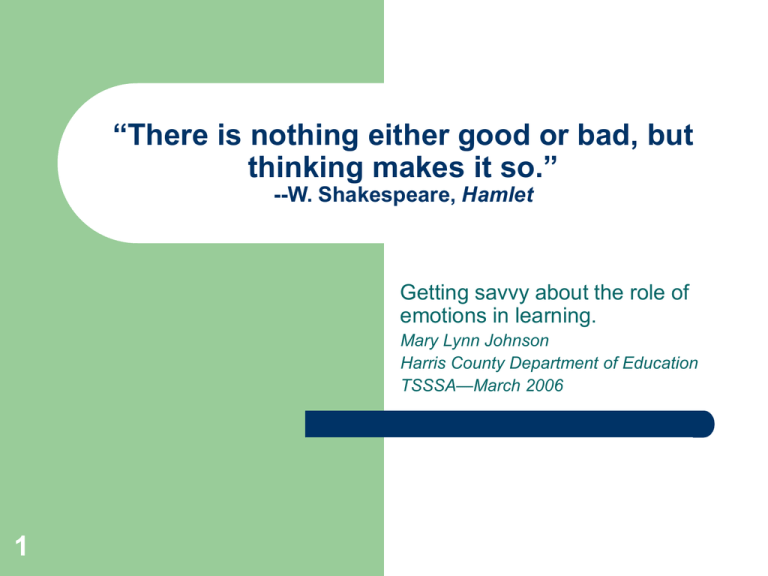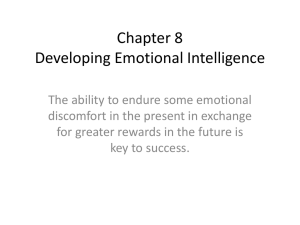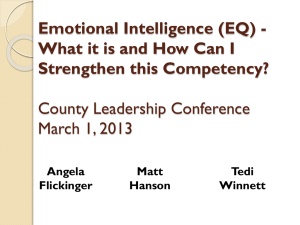1 “There is nothing either good or bad, but thinking makes it so.” -
advertisement

“There is nothing either good or bad, but thinking makes it so.” --W. Shakespeare, Hamlet Getting savvy about the role of emotions in learning. Mary Lynn Johnson Harris County Department of Education TSSSA—March 2006 1 Select one word to describe your emotional state right now 2 Alive Confident Delighted Empowered Enthusiastic Inspired Reflective Overwhelmed Confused Conflicted Discouraged Frantic Rushed Worried Session Content 3 Impact of emotions on learning 4 Emotional states frequently in classrooms Influencing emotional states Emotional Intelligence Categories of Emotions Fear Joy/pleasure/happiness Surprise Disgust Anger Sadness (Rozin, P., 1997) 4 5 Generous Antsy Dislike Numb Startled Disturbed Antagonistic Manic Flabbergasted Thrilled Melancholy Shy Emotions… (Eric Jensen, Teaching with the Brain in Mind, 2005) 6 Constitute the passion for learning Help orchestrate our attentional priorities Support either persistence or retreat Are sources of information about the outside world Emotions, Cont. 7 Evoke necessary empathy, support or fear Associate our learning with either pain or pleasure Help us make meaning out of our learning, work and lives Push the pursuit of rewarded behavior Emotions, Cont. 8 Improve social problem solving Provide incentives for desired social behavior Allow us to enjoy and even celebrate our learning success 4 Emotional States in Classrooms 9 Fear/threat Joy/pleasure Sadness/disappointment Anticipation/curiosity Fear/Threat Fear arises from threat perception. 3 Possible choices of action: Fight Try to escape Freeze 10 Common Threat Experiences in School 11 Peer pressure Deadlines with consequences Being forced to stay after school Making reparations Giving public apologies Violence or perception of violence Stress/distress Distress 12 Heightened excitability or arousal Perception of the event as aversive Loss of control Teachers and Stress Females tend to increase nurturing behaviors. Males tend to show withdrawal and sarcasm. 13 Joy/Pleasure 14 Emanates from an area near the brain stem Dopamine—the pleasure chemical—pushes toward the front of the brain. This state is essential for all learning. Negative/Positive Emotions Negative emotions during learning create an association that may result in students quitting. Positive emotions during learning create a great association in the brain. 15 A positive emotional state… …leads to improved flexibility in behavior and judgment; …releases high levels of dopamine leading to greater flexibility in the executive attentional system. 16 Sadness/Disappointment 17 Experienced in the lower half of the brain Originates in the temporal lobes Pain and sadness last longer than joy Remembering negative biases cause us not to repeat them Anticipation/Curiosity 18 Create a positive state of hope and vigilance Increased activity in attentional areas of the brain “Appetitive” states Highly motivating states Influencing Emotional States 1. 2. 3. 4. 5. 19 They are ubiquitous. They are connected. They are not who we are. They are transient. Stable emotional states can be a problem. Teacher Influence Compelling questions Role modeling Celebrations Physical activity Engineered controversy Purposeful physical rituals Getting personal 20 Emotional Intelligence--Defined The capacity for recognizing our own feelings and those of others, for motivating ourselves, and for managing emotions well in ourselves and in our relationships. --Daniel Goleman, 1995 21 5 Dimensions of EQ 1. 2. 3. 4. 5. 22 Self-awareness Self-control Self-motivation Empathy Relationship skills Self-awareness To promote, encourage students to: Reflect on their own emotional states Learn about emotions and theories of emotions Determine the causes and effects of their emotions Expand their emotional vocabulary Identify emotions as they experience them 23 Self-control To control their emotions, encourage students to Role-play emotionally-charged scenarios and ways to respond Use inner dialog or “self-talk” to handle intense emotions Sharpen decision-making skills Practice relaxation techniques Count to 10 when angry, to 100 when really angry Delay gratification 24 Self-motivation To improve self-motivation, encourage students to Set goals for themselves Monitor their effectiveness and modify their approach Persevere with projects and skills Visualize achievement Develop a sense of internal locus of control, optimism, and efficacy 25 Empathy To nurture empathy skills, encourage students to Role-play being others in different scenarios Engage in perspective-taking: seeing the world through the eyes of others Develop cognitive flexibility, examine multiple perspectives Tune into the feelings of others Reflect on the effect of their behaviors on others 26 Relationship Skills To enhance relationship skills, encourage students to Engage in cooperative learning and develop social skills in context Improve leadership skills through organization, communication and inspiration Develop peacemaking, conflict-resolution, mediation and negotiation skills Stretch communications skills (speaking/listening) Interpret the facial expressions and body language of others 27 Relationship Skills 28 29







